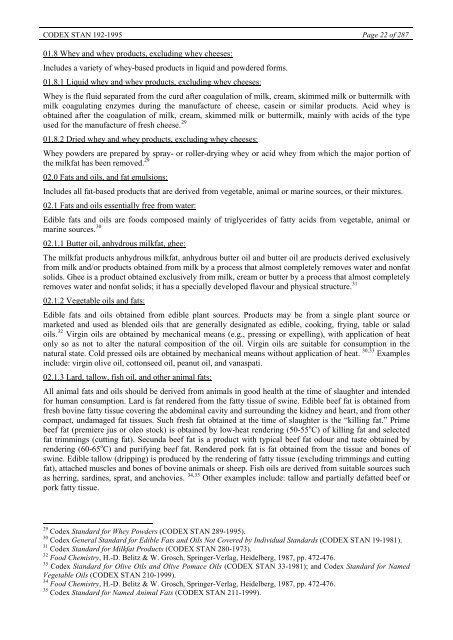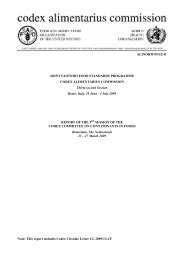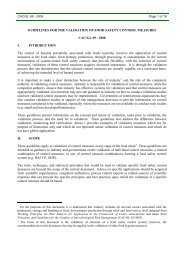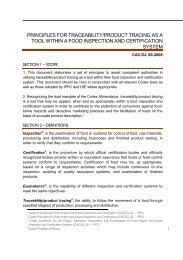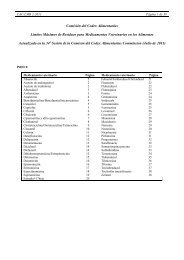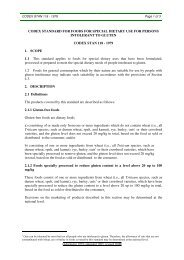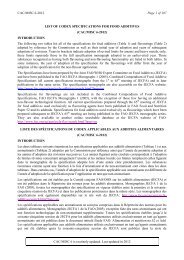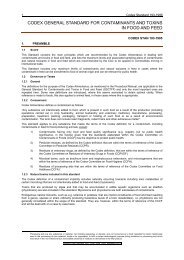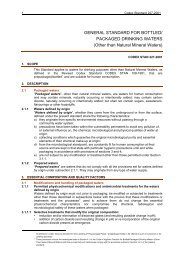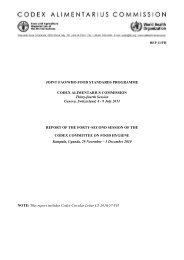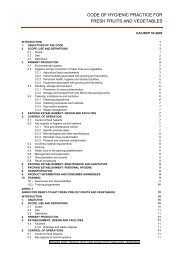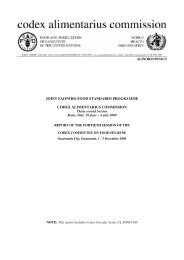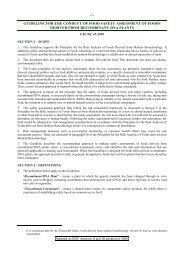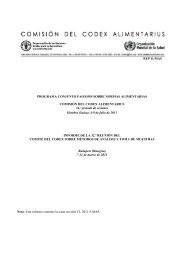General Standard for Food Additives - CODEX Alimentarius
General Standard for Food Additives - CODEX Alimentarius
General Standard for Food Additives - CODEX Alimentarius
You also want an ePaper? Increase the reach of your titles
YUMPU automatically turns print PDFs into web optimized ePapers that Google loves.
<strong>CODEX</strong> STAN 192-1995 Page 22 of 287<br />
01.8 Whey and whey products, excluding whey cheeses:<br />
Includes a variety of whey-based products in liquid and powdered <strong>for</strong>ms.<br />
01.8.1 Liquid whey and whey products, excluding whey cheeses:<br />
Whey is the fluid separated from the curd after coagulation of milk, cream, skimmed milk or buttermilk with<br />
milk coagulating enzymes during the manufacture of cheese, casein or similar products. Acid whey is<br />
obtained after the coagulation of milk, cream, skimmed milk or buttermilk, mainly with acids of the type<br />
29<br />
used <strong>for</strong> the manufacture of fresh cheese.<br />
01.8.2 Dried whey and whey products, excluding whey cheeses:<br />
Whey powders are prepared by spray- or roller-drying whey or acid whey from which the major portion of<br />
29<br />
the milkfat has been removed.<br />
02.0 Fats and oils, and fat emulsions:<br />
Includes all fat-based products that are derived from vegetable, animal or marine sources, or their mixtures.<br />
02.1 Fats and oils essentially free from water:<br />
Edible fats and oils are foods composed mainly of triglycerides of fatty acids from vegetable, animal or<br />
30<br />
marine sources.<br />
02.1.1 Butter oil, anhydrous milkfat, ghee:<br />
The milkfat products anhydrous milkfat, anhydrous butter oil and butter oil are products derived exclusively<br />
from milk and/or products obtained from milk by a process that almost completely removes water and nonfat<br />
solids. Ghee is a product obtained exclusively from milk, cream or butter by a process that almost completely<br />
31<br />
removes water and nonfat solids; it has a specially developed flavour and physical structure.<br />
02.1.2 Vegetable oils and fats:<br />
Edible fats and oils obtained from edible plant sources. Products may be from a single plant source or<br />
marketed and used as blended oils that are generally designated as edible, cooking, frying, table or salad<br />
32<br />
oils. Virgin oils are obtained by mechanical means (e.g., pressing or expelling), with application of heat<br />
only so as not to alter the natural composition of the oil. Virgin oils are suitable <strong>for</strong> consumption in the<br />
30,33<br />
natural state. Cold pressed oils are obtained by mechanical means without application of heat. Examples<br />
include: virgin olive oil, cottonseed oil, peanut oil, and vanaspati.<br />
02.1.3 Lard, tallow, fish oil, and other animal fats:<br />
All animal fats and oils should be derived from animals in good health at the time of slaughter and intended<br />
<strong>for</strong> human consumption. Lard is fat rendered from the fatty tissue of swine. Edible beef fat is obtained from<br />
fresh bovine fatty tissue covering the abdominal cavity and surrounding the kidney and heart, and from other<br />
compact, undamaged fat tissues. Such fresh fat obtained at the time of slaughter is the “killing fat.” Prime<br />
beef fat (premiere jus or oleo stock) is obtained by low-heat rendering (50-55 o C) of killing fat and selected<br />
fat trimmings (cutting fat). Secunda beef fat is a product with typical beef fat odour and taste obtained by<br />
rendering (60-65 o C) and purifying beef fat. Rendered pork fat is fat obtained from the tissue and bones of<br />
swine. Edible tallow (dripping) is produced by the rendering of fatty tissue (excluding trimmings and cutting<br />
fat), attached muscles and bones of bovine animals or sheep. Fish oils are derived from suitable sources such<br />
34,35<br />
as herring, sardines, sprat, and anchovies. Other examples include: tallow and partially defatted beef or<br />
pork fatty tissue.<br />
29<br />
Codex <strong>Standard</strong> <strong>for</strong> Whey Powders (<strong>CODEX</strong> STAN 289-1995).<br />
30<br />
Codex <strong>General</strong> <strong>Standard</strong> <strong>for</strong> Edible Fats and Oils Not Covered by Individual <strong>Standard</strong>s (<strong>CODEX</strong> STAN 19-1981).<br />
31<br />
Codex <strong>Standard</strong> <strong>for</strong> Milkfat Products (<strong>CODEX</strong> STAN 280-1973).<br />
32<br />
<strong>Food</strong> Chemistry, H.-D. Belitz & W. Grosch, Springer-Verlag, Heidelberg, 1987, pp. 472-476.<br />
33<br />
Codex <strong>Standard</strong> <strong>for</strong> Olive Oils and Olive Pomace Oils (<strong>CODEX</strong> STAN 33-1981); and Codex <strong>Standard</strong> <strong>for</strong> Named<br />
Vegetable Oils (<strong>CODEX</strong> STAN 210-1999).<br />
34<br />
<strong>Food</strong> Chemistry, H.-D. Belitz & W. Grosch, Springer-Verlag, Heidelberg, 1987, pp. 472-476.<br />
35<br />
Codex <strong>Standard</strong> <strong>for</strong> Named Animal Fats (<strong>CODEX</strong> STAN 211-1999).


